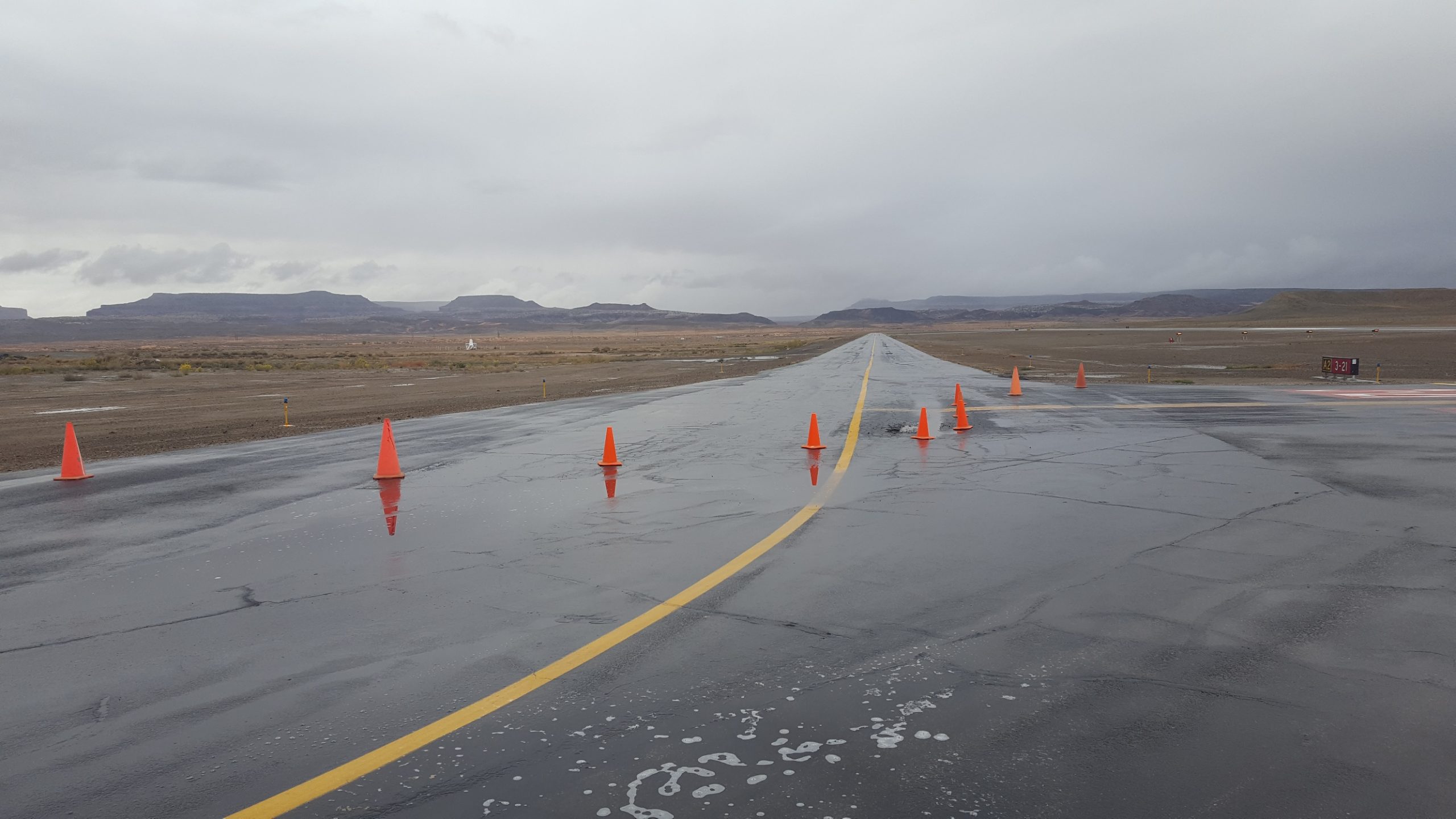Some information may be outdated.
Grand County Airport Manager Judd Hill could either curse — or thank — an unknown pilot who likely caused thousands of dollars in damage last week to Canyonlands Field Airport’s taxiway.
Airport employees first discovered a large pothole and a series of smaller ruts in the taxiway’s surface on Monday, Oct. 8. Hill suspects that a pilot drove a large aircraft across a weak spot in the surface that grew even weaker as heavy rainfall saturated the area, creating a 3-inch depression that’s about 2 feet wide and 5 feet long.
“We have the ability to put out notices to airplanes that are coming in, saying, ‘Hey, be mindful of this (situation),’” he told the Moab Sun News. “Someone didn’t pay attention to that.”
On the upside, however, the discovery of the damage has spurred the airport’s long-gestating plans to build a new taxiway, which connects the runway with the terminal, hangars and other facilities. Hill said that Canyonlands Field plans to submit its project funding request to the Federal Aviation Administration (FAA) by month’s end — well ahead of a previous goal to file that request sometime in 2021.
Hill planned to meet with the airport’s engineers on Wednesday, Oct. 17, to discuss a short-term fix to the damage, and he anticipates that the pothole and ruts could be repaired by sometime next week.
“We’re literally using the same method as filling in a big pothole on a city street,” he said.
Right now, five of seven runway exits to the taxiway are blocked off.
“(The damage is) bad enough that it’s not good for aircraft,” he said.
Grand County Airport Board chair Bill Groff said airport officials understood that conditions on the ground were such that even smaller aircraft had to be kept away from certain areas.
“I know that when we were having all that rain, there were places where we couldn’t even let the small planes land because it was so spongey and squishy,” Groff said.
But Hill said the closures have not affected flight times at Canyonlands Field. Depending on which way the wind is blowing, Hill said that arrivals — or conversely, departures — might be delayed for several minutes at most.
He compares the situation to a hypothetical road construction project in downtown Moab that would lead to minor detours.
“The equivalent would be closing one block of Main Street,” he said. “Traffic does have a way to get around it … You can bypass it.”
Video surveillance of the taxiway was not up and running while it was raining heavily last week, Hill said, so it’s unknown who’s to blame for the damage.
RUNWAY UPGRADES BRING MORE PLANES TO AIRPORT
The current taxiway dates back to the 1990s, long before larger aircraft were flying in and out of Canyonlands Field.
Today, Hill said, large aircraft account for about 10 percent of the airport’s takeoffs and landings, while smaller planes make up the overwhelming majority of flights to and from Canyonlands Field.
However, those trends could change in the future.
This spring, the airport’s runway was upgraded to accommodate bigger planes, such as the 50-seat CRJ200 jets that Essential Air Service carrier SkyWest is now flying under the United Airlines Express banner.
Even before work on those upgrades began, Canyonlands Field surpassed the magical number of 10,000 annual enplanements in 2017, making it eligible for increased federal funding. And with more than two months to go before 2018 comes to an end, Hill said, the airport has already shattered last year’s record of 10,032 enplanements.
“We beat that (2017 record) in just over five months and a week,” he said.
Hill estimates that it will cost about $5 million to install a new taxiway — a project that was previously identified in the airport’s capital improvement plan, due to its aging condition.
“Our taxiway’s in dire straits, and it’s on our airport board’s plan to get it (replaced),” Groff said.
If the FAA approves the airport’s request and Grand County is designated as an “economically distressed” county — as it was in the 2018 fiscal year — the agency would fund 95 percent of the replacement project, while the county would be responsible for the remaining 5 percent. Without that designation, Hill said, the county’s share of the funding burden would increase by just over 4 percent, to slightly more than 9 percent of the total project costs.
However, funding levels could vary, Groff said, depending on how much money Congress decides to give the FAA. He anticipates that the airport may not receive any funding until next October, but he’s hopeful that the project will finally get off the ground.
“It is a high priority,” Groff said.
Pilot error, heavy rainfall likely to blame for damage at Canyonlands Field
“We have the ability to put out notices to airplanes that are coming in, saying, ‘Hey, be mindful of this (situation),’ … Someone didn’t pay attention to that.”
Appreciate the coverage? Help keep local news alive.
Chip in to support the Moab Sun News.





